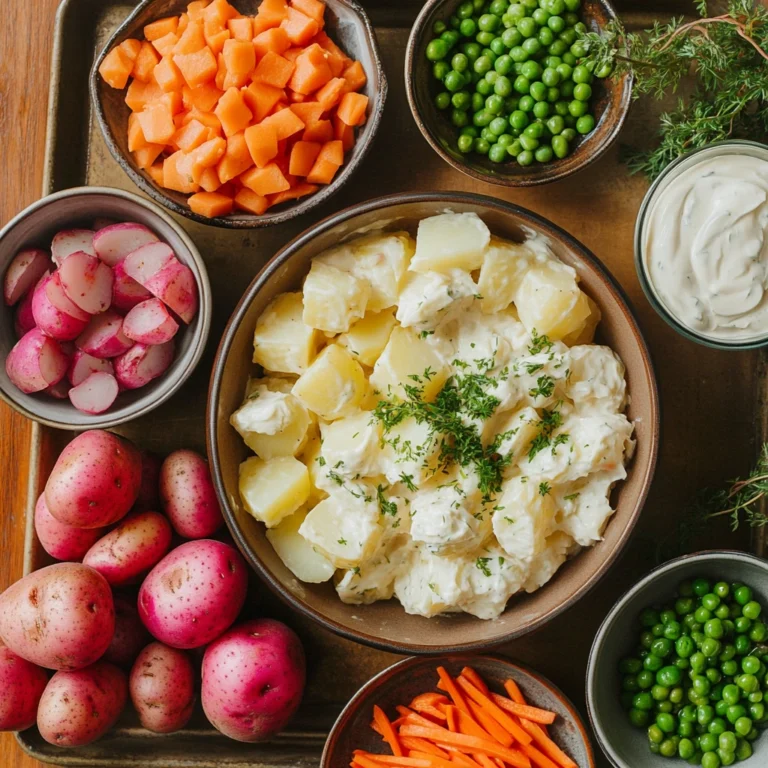Introduction
When it comes to making the perfect potato salad, every step counts. From choosing the right potato variety to boiling them to perfection, small details can make or break this classic dish. One of the most debated steps is whether to rinse potatoes after boiling them, particularly for potato salad. Should you rinse them in cold water, or let them cool naturally? Each approach has its pros and cons, influencing texture, flavor, and the overall quality of your salad. This article dives deep into the science, expert opinions, and practical tips for preparing the best potatoes for your next salad.
Table of contents
Best Practices for Boiling Potatoes
Selecting the Right Potato Variety
Choosing the right potatoes is the first step toward a stellar salad. Waxy varieties like red potatoes and Yukon Gold are ideal because they hold their shape better during boiling, ensuring a firm and creamy texture. Their low starch content means they won’t turn mushy when you mix in the dressing. For creamier salads, consider a mix of waxy and starchy potatoes like Russets, which add a fluffy texture.
Steps to Boil Potatoes Perfectly
Perfectly boiled potatoes are the foundation of a great salad. Start by scrubbing the potatoes under running water to remove dirt—this ensures a clean peel or skin when served. Place the potatoes in a pot and cover them with cold water. Adding salt at this stage enhances their natural flavor.
Bring the water to a boil, then reduce it to a simmer. Avoid rapid boiling, which can cause uneven cooking. Potatoes are done when they’re tender enough to be pierced easily with a fork.
Common Mistakes to Avoid During Boiling
Even a small mistake can ruin your potatoes. One common error is cutting them too small before boiling. While smaller pieces cook faster, they can become waterlogged or overly soft, leading to a mushy salad. Similarly, boiling at high heat throughout can break the potatoes’ exterior before the inside cooks evenly. Instead, use gentle heat for consistent results.
The Debate: To Rinse or Not to Rinse After Boiling
The question of whether to rinse potatoes after boiling often divides culinary experts and home cooks alike. While rinsing has its advantages, some argue that skipping this step is key to achieving the perfect potato salad. Let’s break down both sides of the debate.
Arguments for Rinsing Potatoes in Cold Water After Boiling
Benefits of Rinsing to Remove Excess Starch
Rinsing potatoes in cold water after boiling helps remove surface starch, which can be beneficial depending on your recipe. When preparing a salad, excessive starch might lead to potatoes sticking together or turning gummy once mixed with other ingredients. Rinsing ensures a cleaner surface, reducing the likelihood of this sticky texture. It also cools the potatoes quickly, making them easier to handle and slice evenly—a must for creating a visually appealing salad.
Impact on Potato Texture and Firmness
By rinsing boiled potatoes with cold water, their cooking process is halted immediately. This technique, known as “shocking,” helps lock in their firmness. If you prefer potato salad with distinct, slightly crisp chunks rather than softer, creamier textures, rinsing can make all the difference. Shocking potatoes also maintains their shape, especially for waxy varieties like red potatoes, which are prone to breaking down if left to overcool naturally.
Arguments Against Rinsing Potatoes After Boiling
Retaining Natural Starch for Creamier Texture
On the flip side, some chefs argue that leaving boiled potatoes unrinsed allows them to retain their natural starch—a crucial component for creamier salads. Starch helps bind the dressing to the potatoes, creating a more cohesive dish. Without rinsing, the slightly sticky texture aids in holding seasonings, herbs, and dressings better, preventing the salad from feeling dry or disjointed.
Potential Nutritional Losses from Rinsing
Rinsing boiled potatoes might also wash away some of the water-soluble nutrients, including potassium and vitamin C. For those who value the nutritional content of their dishes, skipping the rinse might be the better choice. Furthermore, cooling the potatoes naturally allows them to absorb a hint of salt from the cooking water, enhancing their flavor subtly without needing additional seasoning.
Nutritional Content of Boiled Potatoes (per 100g)
Boiled potatoes are not only a versatile ingredient but also a healthy addition to your diet. Here’s a breakdown of their nutritional content:
| Nutrient | Amount (per 100g) |
|---|---|
| Calories | 87 kcal |
| Carbohydrates | 20 g |
| Protein | 1.9 g |
| Fat | 0.1 g |
| Fiber | 1.8 g |
| Vitamin C | 8.0 mg |
| Potassium | 379 mg |
| Iron | 0.3 mg |
Expert Recommendations
When it comes to preparing the perfect potato salad, culinary experts have valuable insights into whether you should rinse potatoes after boiling. Their recommendations often consider the desired texture, flavor, and overall outcome of the dish. While preferences vary, there’s a common consensus on tailoring the method to your salad style.
Culinary Experts’ Opinions on Rinsing Potatoes
Most chefs agree that rinsing boiled potatoes can be a useful technique, particularly if you’re aiming for a salad with distinct, firm chunks. Renowned culinary figures suggest that shocking potatoes in cold water halts cooking instantly, helping maintain structure and making them easier to slice or dice. However, they also emphasize the importance of skipping the rinse if you want a creamier texture, as the natural starch contributes significantly to the binding of ingredients.
For those new to potato salad preparation, experts recommend experimenting with both rinsing and non-rinsing techniques to find what works best for your recipe. The choice often depends on your dressing and desired consistency.
Suggested Practices for Optimal Potato Salad Texture
To achieve the best texture, experts advise cooling potatoes just enough before handling them. Use rinsing sparingly, only when necessary to firm up potatoes for chunkier salads.
Balancing Starch Content for Desired Creaminess
For creamy salads, avoid rinsing. Instead, let the potatoes cool naturally and absorb some of the residual moisture. This enhances the overall cohesiveness of the salad, ensuring each bite is flavorful and satisfying.
Practical Tips for Preparing Potatoes for Salad
Potatoes are the star of any great potato salad, so mastering their preparation is essential. While the rinsing debate continues, there are other ways to ensure your potatoes have the perfect texture and flavor for your salad. From boiling techniques to innovative cooling methods, these tips will elevate your dish.
Achieving the Ideal Potato Texture Without Rinsing
Controlling Boiling Time to Prevent Overcooking
The key to perfect potato texture lies in careful timing. Always start with cold water, bringing the potatoes and water to a boil together. This ensures even cooking from the inside out. Check for doneness frequently by piercing with a fork; the potatoes should be tender but not falling apart. Waxy varieties like red potatoes or Yukon Golds are less prone to overcooking but still require close attention to avoid a mushy texture.
Techniques to Cool Potatoes Without Rinsing
Instead of rinsing, spread boiled potatoes in a single layer on a baking sheet to cool naturally. Place them in a well-ventilated area or near a fan to speed up the process. Another method is to toss hot potatoes gently in a little olive oil or vinegar, which helps them cool more quickly while adding flavor. These techniques preserve the potatoes’ natural starch and help retain nutrients.
Alternative Methods to Manage Starch Content
Pre-Boiling Rinsing Techniques
If excess starch is a concern, rinse the potatoes thoroughly before boiling. This removes surface starch without disrupting their texture post-cooking. Washing potatoes under cold running water before placing them in the pot can also reduce stickiness while ensuring they retain their natural structure after boiling.
Utilizing Vinegar or Salt in Boiling Water
Adding a splash of vinegar or a generous pinch of salt to the boiling water not only enhances flavor but also helps manage starch content. Vinegar prevents potatoes from breaking down too quickly, ensuring firmer slices, while salt helps season the potatoes from the inside out. These simple tweaks can make a noticeable difference in the final dish.
Part 6: Frequently Asked Questions About Preparing Potatoes for Salad
When preparing potato salad, it’s common to encounter questions about the best methods for cooking and handling potatoes. Here are some of the most frequently asked questions to help you perfect your salad-making skills.
Should I Rinse Potatoes Before Boiling for Salad?
Yes, rinsing potatoes before boiling is a good practice. This step removes dirt, debris, and some surface starch, ensuring the potatoes cook evenly and remain clean. While rinsing after boiling is debated, rinsing beforehand helps maintain a clean exterior and reduces any potential stickiness later.
How Can I Prevent My Potato Salad from Becoming Watery?
To avoid watery potato salad, ensure that your potatoes are properly drained and cooled before mixing them with the dressing. Use waxy potato varieties like red or Yukon Gold, as they hold less water than starchy ones. Additionally, avoid overboiling, which can cause potatoes to absorb too much moisture.
Is It Better to Peel Potatoes Before or After Boiling for Salad?
This depends on your preference. Peeling after boiling is often easier, as the skins slip off effortlessly when the potatoes are cooked. However, if you prefer firmer edges or need uniform slices, peeling before boiling may be the better option.
How Long Should I Let Potatoes Cool Before Mixing the Salad?
Potatoes should cool for at least 15-20 minutes to reach room temperature before mixing. This ensures the dressing adheres properly and prevents it from separating. Cooling naturally or using a fan helps maintain the texture without excess moisture.
Conclusion
Making an Informed Decision on Rinsing Potatoes After Boiling
Deciding whether to rinse potatoes after boiling depends on the type of potato salad you’re aiming to create. Rinsing helps remove excess starch and cools potatoes quickly, resulting in a firmer texture perfect for chunkier salads. On the other hand, skipping the rinse retains the natural starch, enhancing creaminess and flavor cohesion. By understanding the effects of each method, you can tailor your preparation process to suit your preferences and ensure a delicious result every time.
Summary of Key Points
Rinsing potatoes after boiling has its pros and cons. While it can enhance firmness and prevent overcooking, it may wash away nutrients and reduce creaminess. The choice should align with your desired salad texture and flavor profile. Using the right potato variety and proper boiling techniques further ensures a great outcome.
Final Recommendations for Potato Salad Preparation
For chunkier salads, rinse boiled potatoes in cold water to preserve their shape. For creamier salads, skip rinsing and let the potatoes cool naturally to retain starch. Experiment with boiling times, cooling methods, and dressing styles to find what works best for your tastes. With these tips, your potato salad will always impress!
What is ensalada rusa made of?
Ensalada rusa, also called Russian salad, is a classic Spanish dish made primarily with boiled potatoes, carrots, and peas, combined with creamy mayonnaise. Regional variations often add ingredients like tuna, pickles, boiled eggs, or olives to enhance its flavor and texture.
What is Spanish potato salad made of?
Spanish potato salad, commonly known as ensaladilla rusa, features a base of boiled potatoes, carrots, and peas, all bound together with mayonnaise. Variations might include additions such as tuna, olives, or hard-boiled eggs, reflecting personal or regional preferences.
Who puts potato salad in gumbo?
In Louisiana’s Creole and Cajun cuisine, potato salad is often served alongside gumbo. While some enjoy it as a side dish, others prefer placing a scoop of potato salad directly on top of their gumbo. This tradition adds a creamy texture and a contrasting flavor to the rich and hearty dish.

